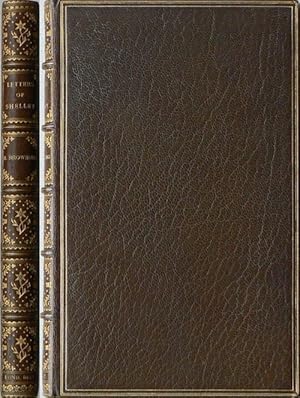About this Item
Octavo, ca. 197 x 124 mm. Erste Auflage, vi, [1], [1 blank], 165, [2], [1 blank] pp. - 8 pp. (List of Books). Ganzleder Handeinband mit reicher Vergoldung. Sprache: Englisch, (Einband minimalst berieben, erste und letzte Blätter braunfleckig, sehr schönes Exemplar). Contemporary olive morocco (203 x 133 x 17,5 mm), spine with five raised bands, panelled and lettered in gilt, richly gilt with gilt fleural tools and lines, boards with gilt line panels. Top edge gilt, burgundy endleaves. Bound by Riviere & Son, and signed on upper turn-in. This is the first edition of the Browning Essay. Edward Moxon bought twenty three letters at a Sotheby & Wilkinson sale, 12 May 1851. The vendor of these letters was the bookseller William White who had obtained them, with other items including Byron forgeries, from 'Major George Gordon de Luna Byron', also known as DeBibler, who claimed to be the illegitimate son of the poet Byron by a Spanish lady. The son of Sir Francis Palgrave realised that Letter XXI to William Godwin from Florence was cribbed from a letter to his father. "An ingenious forgery perpetrated by an impostor, claiming to be the [natural] son of Lord Byron. Two genuine letters, which happened to be in Moxon's hands, were included. The fraud was discovered, to the chagrin of Browning and Moxon, who at once destroyed all obtainable copies of the book" (Granniss). The two genuine letters in the present volume are No. V to Sir James Henry Lawrence, August 17, 1812 (= Ingpen #186; de Ricci 186) and No. XXIII to Keats, Pisa, July 27, 1820 (= Ingpen #484; de Ricci 484). "One of the most ingenious literary forgeries of modern times is recalled by a rare work which a London bookdealer now is offering for sale for $375. It is an octavo volume published in 1852 by Moxon and entitled 'Letters of P. B. Shelley, with an introductory essay by Robert Browning. Browning really wrote the introduction, but not one of the twenty-five letters in it is by Shelley. These letters purported to have been sent by Percy Bysshe Shelley, the eminent English poet, to various of his friends. They were clever imitations of his hand-writing, and bore the postmarks of cities in which it was known that Shelley had resided. The book made a sensation. Browning's preface is one of his most admired pieces of prose writing. Moxon sent copies of the work to a number of distinguished literary men, among others Lord Alfred Tennyson. Francis Turner Palgrove, son of Sir Francis Palgrove, the historian, was at the time a guest of Lord Tennyson. He picked up the book one day and opened it at a letter from Shelley to Godwin, his father-in-law, which seemed strangely familiar to him. He read on and found that the letter was a plagiarism of an article which his father had contributed to the Quarterly Review in 1840. Moxon, when informed of this discovery, said that he had bought the letters at a public sale, and that they seemed authentic. The handwriting appeared genuine, the seal was Shelley's and the addresses bore the stamp of the Post Offices of the italian towns where Shelley had lived. It happened that, at the same sale, the poet's son, Sir Percy Florence Shelley, had bought other letters of his father, which were of a private and personal character. These letters were found to be at utter variance with well-known facts. Moxon at once suppressed the book, the auctionneer said that the letters had come to him from a bookseller named W. White. White, in turn, said that he had bought them from an unknown woman who claimed to have received them from Fletcher, Lord Byron's servant. Further search revealed that behind this unknown woman was the forger, George Gordon Byron, alias De Gibler. This adventurer bore a striking resemblance to Lord Byron, had assumed his name, and had passed himself off as Byron's natural son. He almost succeeded in palming off on a publisher some unedited remains of Lord Byron. As soon as the facts about the letters became known he . Seller Inventory # 951865
Contact seller
Report this item
![]()





